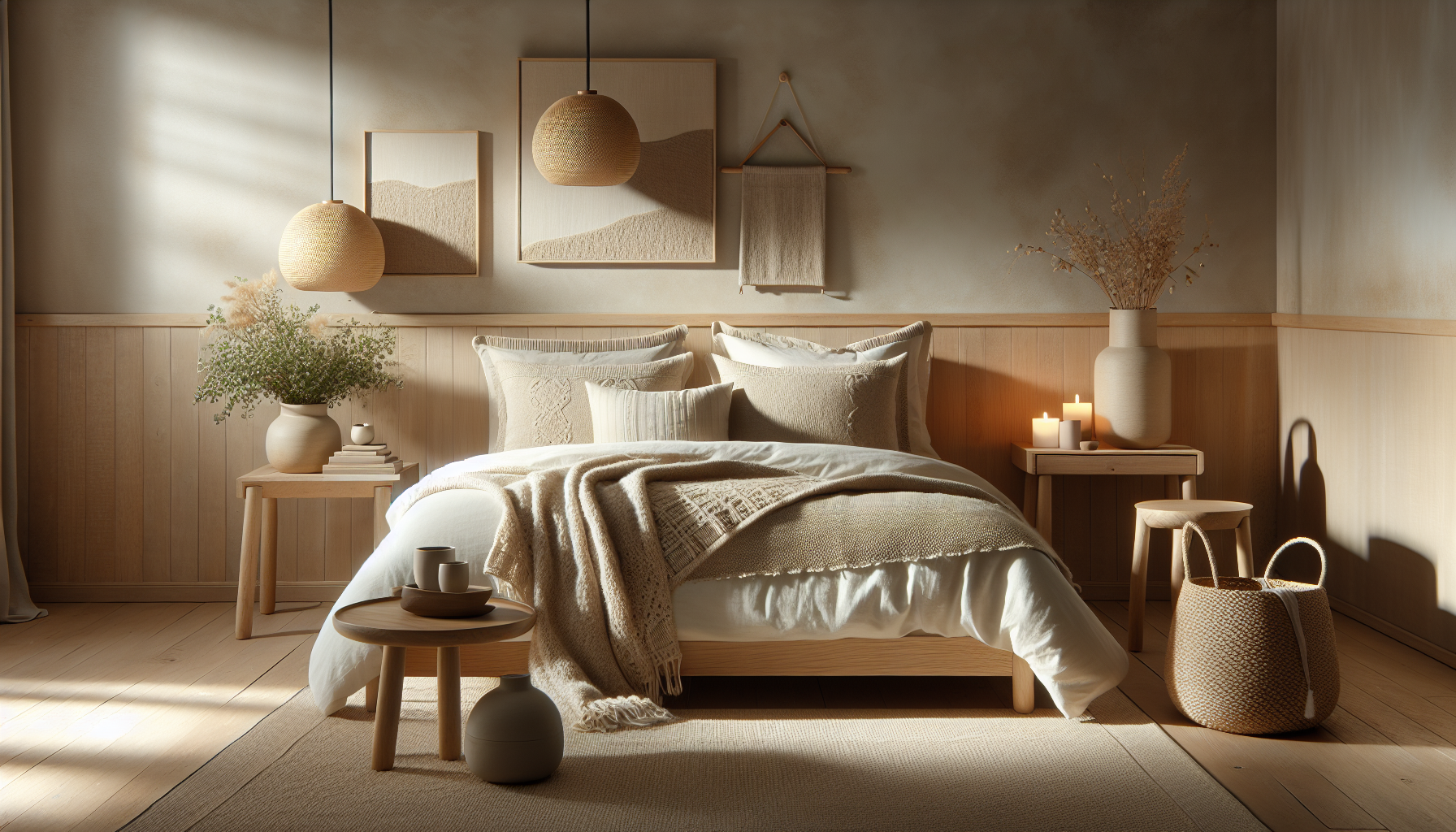What if the way you design your bedroom could significantly impact your sleep quality? It sounds intriguing, doesn’t it? Let’s explore the fascinating intersection of design aesthetics, particularly Japandi style, and how they can contribute to a more restful night’s sleep.
Understanding Japandi Design
Japandi design is an inspiring blend of Japanese and Scandinavian aesthetics. This style emphasizes simplicity, functionality, and natural elements, embodying a serene and tranquil atmosphere. It’s all about creating a cohesive space that promotes calmness, which is essential for good sleep.
The Core Principles of Japandi Design
At its heart, Japandi design operates on several core principles:
-
Minimalism: Clutter-free spaces allow the mind to relax. When there’s less visual noise, you can focus better and unwind in your sanctuary.
-
Natural Materials: Wood, stone, and textiles produced from natural fibers help create an organic feel. These materials often evoke a sense of connection to nature, which can be soothing and promote relaxation.
-
Neutral Tones: Soft, muted color palettes characterize Japandi. Colors like ivory, beige, and soft greens can create a calming environment, making it easier for you to drift off to sleep.
-
Functional Beauty: Every piece in a Japandi space is purposeful, combining form and function. By filling your space with intentionally chosen items that serve a dual purpose, you minimize distractions and help create a peaceful environment.
How Japandi Design Can Enhance Your Sleep Environment
Now that you’re familiar with the key principles of Japandi design, let’s discuss how these elements can directly influence your sleep quality.
Creating a Calm Ambiance
The soothing atmosphere created by neutral tones and natural materials can promote relaxation. When you step into a bedroom designed in the Japandi style, you’re met with a sense of calm that allows your thoughts to settle, paving the way for restful sleep.
Reducing Clutter
A cluttered space can lead to a cluttered mind. Japandi design emphasizes minimalism, which means less visual clutter in your room. When your environment is uncluttered, it can reduce anxiety and stress levels, making it easier for you to unwind at the end of the day.
Prioritizing Quality Sleep Accessories
In Japandi design, the focus is on quality over quantity. When selecting bed linens, curtains, and other sleep accessories, you should opt for high-quality, natural materials that feel good against your skin. Organic cotton, linen, and wool can enhance your comfort, creating a more conducive environment for sleep.
The Role of Color in Sleep Quality
Not all colors promote good sleep. The neutral tones typical in Japandi design play a key role in influencing your sleep quality.
Calming Color Palettes
Colors significantly impact mood and wellbeing. Soft earth tones tend to evoke feelings of calm and tranquility. For instance, consider painting your bedroom walls in pale green or soft beige rather than bold, bright colors like red or yellow, which can be stimulating.
Accent Colors for Depth
While the overall palette should remain soft and calming, adding a few muted accent colors can create depth and warmth in the space without overwhelming it. A dark navy blue or forest green can enhance the coziness of the room while still remaining tranquil.
Thoughtful Furniture Choices
The furniture in your bedroom can also impact sleep quality. In a Japandi-styled bedroom, furniture pieces are carefully selected for both beauty and functionality.
Low Profile Beds
Low-profile platform beds are a staple in Japandi design. They create a sense of serenity and provide easier access to the bed, inviting you to relax. Furthermore, these beds can make the room feel more spacious, which can lend itself to a more serene atmosphere.
Functional Storage Solutions
Storage is crucial for maintaining a clutter-free environment. Japandi style encourages built-in storage solutions that blend seamlessly with the room’s design. You might opt for bedside tables with drawers or multi-functional furniture like ottomans that offer hidden storage.
Lighting Design for Restful Sleep
Lighting plays a critical role in setting the mood in your bedroom. In Japandi design, light sources are often natural and soft to create a cozy atmosphere.
Natural Light
Maximizing natural light during the day can help regulate your circadian rhythm. Keep your windows unobstructed and use light, airy curtains that allow light to filter in while ensuring privacy.
Layered Lighting
At night, it’s essential to create a soft lighting environment. Incorporate layered lighting options—overhead fixtures paired with bedside lamps or wall sconces give you flexibility. Dimming lights in the evening can help signal to your body that it’s time to prepare for sleep.
The Importance of Textiles
Textiles are the unsung heroes of sleep quality. In a Japandi bedroom, you should choose textiles with a focus on comfort and natural materials.
Choosing Bedding Wisely
Opt for bedding made from organic materials such as cotton or bamboo, which are breathable and hypoallergenic. High thread counts can be cozy but ensure the fabric is also lightweight to promote better temperature regulation during sleep.
Soft Rugs for Comfort
If you have hard flooring, consider adding a soft, natural fiber rug to your bedroom. This can improve comfort underfoot and add warmth and texture to your space, which can make it feel more inviting.
Incorporating Nature into Your Bedroom
Nature has a profound effect on our psychological well-being. Bringing elements of nature into your bedroom design can help create a soothing environment.
Indoor Plants
Adding plants to your room can purify the air and improve overall mood. Low-maintenance plants like snake plants or peace lilies can thrive in indoor settings and require minimal care. They can also provide a splash of greenery that enhances your room’s aesthetic.
Natural Elements in Decor
Consider using decorative accents that reflect nature, such as wooden sculptures, stone vases, or woven baskets. These elements reinforce the connection to the outdoors, adding to the calming ambiance essential for good sleep.
The Zen Aspect of Japandi Design
Japandi design draws inspiration from Zen philosophy, focusing on mindfulness and simplicity. Implementing these principles in your bedroom can facilitate better sleep.
Mindfulness Practices
Incorporate elements that encourage mindfulness, such as a meditation corner or a space for yoga. Quiet moments before bed can help you detach from the stress of the day, making it easier to transition into sleep mode.
Intentional Space Planning
Every piece in a Japandi bedroom serves a specific purpose. By intentionally organizing your furniture and decor, you minimize distractions, allowing you to focus on relaxation and sleep.
Balancing Functionality and Aesthetics
One of the beauties of Japandi design is its ability to marry form and function seamlessly. Your bedroom should be a space that is not just visually pleasing but also serves its purpose effectively.
Multi-functional Furniture
Look for furniture that can serve multiple purposes, such as a bench that can provide storage while doubling as additional seating. This approach helps maximize space while maintaining a clean, organized feel.
Personal Touches for Your Space
While Japandi design has its rooted principles, personal touches are what will ultimately make the space feel like yours.
Meaningful Decor
Incorporate items that hold significance, such as photographs, artwork, or souvenirs from travels. Ensure these items fit harmoniously within the minimalist ethos of Japandi design, allowing your personality to shine without cluttering the space.
Personalized Bed Linens
Whether it’s embroidered pillowcases or your favorite blanket, choose bed linens that reflect who you are. Personal touches not only enhance comfort but also make your space feel inviting and familiar.
Consistency in Design Choices
Consistency in design will ensure a cohesive look throughout your bedroom while promoting calmness and relaxation.
Uniform Color Scheme
Choose a color palette and stick with it throughout your bedroom. This will create a serene atmosphere and aid in achieving consistency within different elements of the room.
Conclusion: The Power of Design in Your Sleep Quality
So, can Japandi design influence better sleep quality? Absolutely. The tranquil elements of this aesthetic—minimalism, natural materials, neutral tones, and a focus on functionality—combine to create an environment perfectly suited for relaxation and rest. By implementing some of these strategies, you can transform your bedroom into a serene sanctuary that not only looks beautiful but also supports your well-being.
Remember, your bedroom should be a space that promotes peace, comfort, and tranquility. By embracing the principles of Japandi design, you are taking a significant step toward healthier sleep quality. Explore your personal style within this framework and enjoy the benefits of a well-designed, restful environment.

